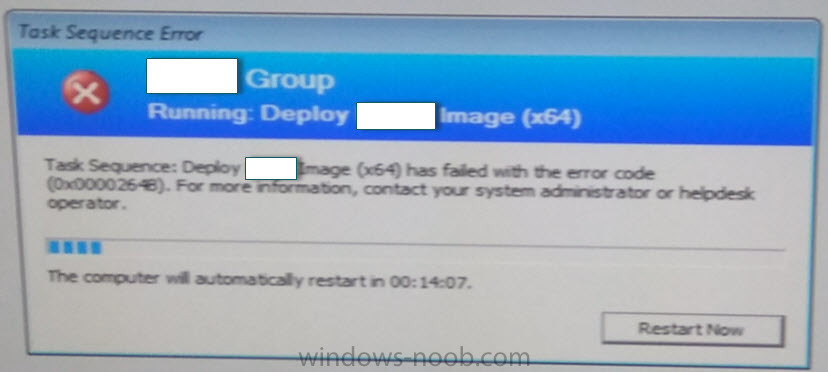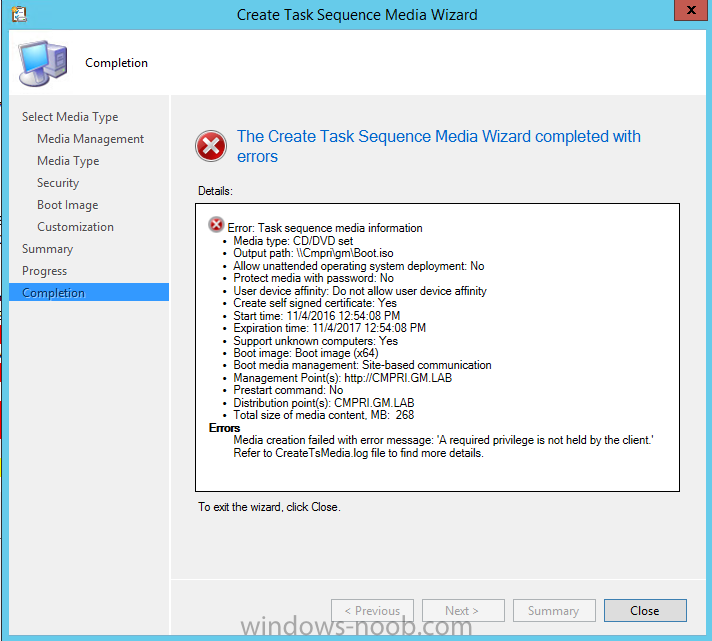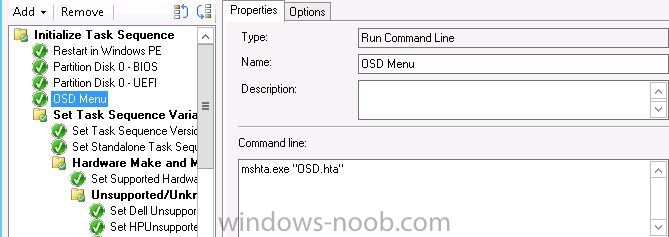Search the Community
Showing results for tags 'Task sequence'.
-
Domain join fails for a single model
blind3d posted a question in Deploy software, applications and drivers
Helloy guys, I'm experiencing a very strange behaviour in SCCM OS deployment... my task sequence seems to work fine for all laptops, desktops, tablets etc. except for one laptop model (Deployment for Lenovo E570 - Win 7 OS). I assume that there is a driver issue ,but I simply can't solve it.. During the task sequence the join to the domain "fails". The log claims that no adapters are found. Funny thing is, that during the TS the drivers are installed and after the TS completes, the NIC is present in the device manager. So WTF!? All other models are working fine... I've removed the complete NIC drivers from the package and re-added them. And I added different driver versions. Even added the driver to the boot-image. No success... *UPDATE* I figured out that, after the driver has been installed the adapter is not loaded. When u open a cmd and run ipconfig only the WiFi adapter is present... HEEELP!!- 2 replies
-
- driver package
- domain join
-
(and 1 more)
Tagged with:
-
Hi, I've been having problems with an install for a looong time. I need to install the latest Salesforce plugin for outlook on my companies computer but many different versions are installed which I need to uninstall prior to installing the newer version.To do so, I have found a Powershell script that if I run from PS ISE works correctly however, if I do it from a task sequence it says it has run but it doesn't do anything.This is how I did it: Created a package with the .ps1 file with no program. Added a Run powershell script step where I invoke the package and specified the script name. After many troubleshooting I think it could have to do with the account the task sequence is executed.The PS script is the following: $uninstall32 = gci "HKLM:\SOFTWARE\Wow6432Node\Microsoft\Windows\CurrentVersion\Uninstall" | foreach { gp $_.PSPath } | ? { $_ -match "Salesforce*" } | select UninstallString $uninstall64 = gci "HKLM:\SOFTWARE\Microsoft\Windows\CurrentVersion\Uninstall" | foreach { gp $_.PSPath } | ? { $_ -match "Salesforce*" } | select UninstallString if ($uninstall64) { $uninstall64 = $uninstall64.UninstallString -Replace "msiexec.exe","" -Replace "/I","" -Replace "/X","" $uninstall64 = $uninstall64.Trim() Write "Uninstalling..." start-process "msiexec.exe" -arg "/X $uninstall64 /q" -Wait} if ($uninstall32) { $uninstall32 = $uninstall32.UninstallString -Replace "msiexec.exe","" -Replace "/I","" -Replace "/X","" $uninstall32 = $uninstall32.Trim() Write "Uninstalling..." start-process "msiexec.exe" -arg "/X $uninstall32 /q" -Wait} it should find the uninstall string for the app and execute it. Also, the app I'm trying to find is installed on the user profile, and if the uninstall string is run from another account it wont find it.... this is why I think it might have to do with the account
- 4 replies
-
- task sequence
- powershell
-
(and 2 more)
Tagged with:
-
Hi, I'm struggling to find a definative answer to a question. Is it possible to rebuild a machine via an OSD task sequence within SCCM 2012 R2? Is SCCM working correctly in that if I have previously built a machine via a task sequence, then try to rebuild that machine it does not see that same task sequence and therefore will not be able to be rebuilt? I have a sequence deployed to all unknown computers. The 1st time it builds fine, if I then try to rebuild, it will not see the task sequence. I am assuming as it's no longer an unknown computer. Part of the sequence places the computer in a specified OU, it seems that sometimes it will see the sequence, sometimes it will not. I am using a usb build key with not pxe boot server. Is it expected behaviour that you should delete the computer from SCCM and then rebuild, is there a work around to allow support staff who don't have access to SCCM to rebuild machines? Any help appreciated.
-
Morning All, I have a Windows 10 Task Sequence for a standalone laptop which I need to encrypt with Bitlocker as part of the OSD build. The machine encrypts with bitlocker fine but I cannot find a way to export the recovery key either to a network share (with appropriate credentials) or the local disk (to then backup from the device) during the task sequence. Wondering if anyone has managed to get this working or if has to remain a manual step, i'd appreciate any help/advice? thanks in advance,
-
Strange issue I cannot find any posts about. I deleted some obsolete driver packages, then the drivers, and then the data files and they still appear in the Task Sequence deployment. Tried a few different script out there to delete driver packages and the did not see them either. Restarts and no success in removing them from the TS Deployment. Server: Windows 2012 R2 SCCM CB 1702, WADK 10.1.15063, MDT 6.3.8443.1000, and SQL 2014 in 2012 mode Thank you.
- 3 replies
-
- sccm
- task sequence
-
(and 2 more)
Tagged with:
-
Hey guys Got a new machine, to image. Imported all the drivers as usual, and the network driver was already in the boot image from an earlier model that uses the exacy same network driver. ( already double checked this to ) Turned off secure boot in the Bios, and attempted to pxe boot into the Task Sequence window. The machine reboots right before it manages to bring up the task sequence window. Looking at the smsts.log it display the error in the subject of this post Did a F8 before it rebooted the second time round and issuing an ipconfig shows no IP address. It just displays Windows Ip Configuration. The network drivers are in the boot image so not sure what else to do here? The machine is a Lenovo M910z (10NU)
-
Hello, I'm having a weird issue with the HP 1030 G2 x360 laptop\convertible. When I tried to image it ,my TS failed to detect it as a Laptop, it turned out that it has a new chassis type 31. So I added the chassis type to the ztigather.wsf, however it still didn't detect the chassis type. If objInstance.ChassisTypes(0) = 12 or objInstance.ChassisTypes(0) = 21 then ' Ignore docking stations Else If not IsNull(objInstance.SMBIOSAssetTag) then sAssetTag = Trim(objInstance.SMBIOSAssetTag) End if Select Case objInstance.ChassisTypes(0) Case "8", "10", "11", "12", "14", "18", "21", "31" bIsLaptop = true Case "3", "4", "5", "6", "7", "15", "16" bIsDesktop = true Case "9" bIsTablet = true Case "23" bIsServer = true Case Else ' Do nothing End Select End if
- 1 reply
-
- chassis type
- sccm
-
(and 2 more)
Tagged with:
-
Hello everyone! I have a few ready-to-deploy OS Task Sequences. They were tested and successfully deployed via SCCM (v.1606) already. And now I have the task to prepare these "OSD-TS"s for installation from USB drive. So the question is: do I have to create new TS, pointing the output to stand-alone media (the very beginning of "New TS Media" Wizard) or there is more quick way like just copy existing TS and "redirect" it's output to stand-alone media? Maybe some kind of PS script can help me? Thank you in advance.
-
- task sequence
- osd
-
(and 1 more)
Tagged with:
-
Hi All, Hope you are all well, and sccm'ing away on the CBB I have been asked to look into a standalone task sequence from usb, which will include the djoin steps for a offline domain join. I went thru the djoin provision steps etc process manually in a lab, and got a fresh build win10 box to join the domain. but cannot seem to get this to work with vanilla sccm cbb. I have read articles that mdt has a specific step for this, but I'm not sure the boss wants mdt in place ?? Anyone got experience of a way to get this to work ? Regards, Wazzie
-
- task sequence
- usb
-
(and 2 more)
Tagged with:
-
Hi guys, I am having an issue deploying a "Required" Task Sequence to our Thin Devices. The devices in question are HP T630's and they have a Unified Write Filter. I am trying to rebuild them using a task sequence which is set to required. The collection where the device resides has a maintenance window set and the deployment has the "Commit changes at deadline or during a maintenance window (requires restarts)" checked. When the maintenance window starts, the device will start a countdown and reboot and go into maintenance mode so the UWF gets disabled, but then nothing happens. If I login with a local admin account and start software center, i can see the Operating System that I am attempting to deploy but it says available rather than required. After a period of time the device will reboot itself again and go back into production mode. If i boot the device off standalone media the task sequence starts immediately which makes me think its something with the config manager client on the device Any help would be appreciated as I am at a bit of a loss. thanks, James
-
Hello, I was able to PXE boot successfully and its able to pickup my WDS Server. I am not able to launch Task Sequence to begin deploying images? All I get is command prompt and it sits there? X:\windows\System32>wpeinit X:\windows\System32> cursor blinking? Help? TaskSequcenProvider log from C:\Program Files\Microsoft Configuration Manager\Logs <![LOG[setting status complete: status code = 0x0; ]LOG]!><time="04:29:19.994+300" date="01-18-2017" component="TaskSequenceProvider" context="" type="1" thread="5344" file="exterror.cpp:128"> <![LOG[[PID: 5220] Invoking method SMS_TaskSequence.ExportXml]LOG]!><time="04:29:20.451+300" date="01-18-2017" component="TaskSequenceProvider" context="" type="1" thread="5344" file="wmiprovider.cpp:333"> <![LOG[[PID: 5220] Done with method SMS_TaskSequence.ExportXml]LOG]!><time="04:29:20.453+300" date="01-18-2017" component="TaskSequenceProvider" context="" type="1" thread="5344" file="wmiprovider.cpp:352"> <![LOG[setting status complete: status code = 0x0; ]LOG]!><time="04:29:20.453+300" date="01-18-2017" component="TaskSequenceProvider" context="" type="1" thread="5344" file="exterror.cpp:128"> <![LOG[[PID: 5220] Invoking method SMS_TaskSequence.LoadFromXml]LOG]!><time="04:29:20.524+300" date="01-18-2017" component="TaskSequenceProvider" context="" type="1" thread="5344" file="wmiprovider.cpp:333"> <![LOG[[PID: 5220] Done with method SMS_TaskSequence.LoadFromXml]LOG]!><time="04:29:20.532+300" date="01-18-2017" component="TaskSequenceProvider" context="" type="1" thread="5344" file="wmiprovider.cpp:352"> <![LOG[setting status complete: status code = 0x0; ]LOG]!><time="04:29:20.532+300" date="01-18-2017" component="TaskSequenceProvider" context="" type="1" thread="5344" file="exterror.cpp:128"> <![LOG[[PID: 5220] Invoking method SMS_TaskSequence.LoadFromXml]LOG]!><time="04:29:28.724+300" date="01-18-2017" component="TaskSequenceProvider" context="" type="1" thread="5344" file="wmiprovider.cpp:333"> <![LOG[[PID: 5220] Done with method SMS_TaskSequence.LoadFromXml]LOG]!><time="04:29:28.731+300" date="01-18-2017" component="TaskSequenceProvider" context="" type="1" thread="5344" file="wmiprovider.cpp:352"> <![LOG[setting status complete: status code = 0x0; ]LOG]!><time="04:29:28.731+300" date="01-18-2017" component="TaskSequenceProvider" context="" type="1" thread="5344" file="exterror.cpp:128"> <![LOG[[PID: 5220] Invoking method SMS_TaskSequence.ExportXml]LOG]!><time="04:29:43.187+300" date="01-18-2017" component="TaskSequenceProvider" context="" type="1" thread="5344" file="wmiprovider.cpp:333"> <![LOG[[PID: 5220] Done with method SMS_TaskSequence.ExportXml]LOG]!><time="04:29:43.192+300" date="01-18-2017" component="TaskSequenceProvider" context="" type="1" thread="5344" file="wmiprovider.cpp:352"> <![LOG[setting status complete: status code = 0x0; ]LOG]!><time="04:29:43.192+300" date="01-18-2017" component="TaskSequenceProvider" context="" type="1" thread="5344" file="exterror.cpp:128"> <![LOG[[PID: 5220] Invoking method SMS_TaskSequence.ExportXml]LOG]!><time="04:29:48.819+300" date="01-18-2017" component="TaskSequenceProvider" context="" type="1" thread="5344" file="wmiprovider.cpp:333"> <![LOG[[PID: 5220] Done with method SMS_TaskSequence.ExportXml]LOG]!><time="04:29:48.821+300" date="01-18-2017" component="TaskSequenceProvider" context="" type="1" thread="5344" file="wmiprovider.cpp:352"> <![LOG[setting status complete: status code = 0x0; ]LOG]!><time="04:29:48.822+300" date="01-18-2017" component="TaskSequenceProvider" context="" type="1" thread="5344" file="exterror.cpp:128"> <![LOG[[C67EB48 PID:5220] Received shutdown request from WMI]LOG]!><time="04:30:29.884+300" date="01-18-2017" component="TaskSequenceProvider" context="" type="1" thread="5344" file="wmiprovider.cpp:399"> <![LOG[[FFD9EB48 PID:96] Initializing provider for namespace root\sms\site_GM1]LOG]!><time="04:31:24.783+300" date="01-18-2017" component="TaskSequenceProvider" context="" type="1" thread="4820" file="wmiprovider.cpp:90"> <![LOG[[FFD9EB48 PID:96] Initialization of provider for namespace root\sms\site_GM1 succeeded]LOG]!><time="04:31:24.783+300" date="01-18-2017" component="TaskSequenceProvider" context="" type="1" thread="4820" file="wmiprovider.cpp:107"> <![LOG[[PID: 96] Invoking method SMS_TaskSequence.ExportXml]LOG]!><time="04:31:24.787+300" date="01-18-2017" component="TaskSequenceProvider" context="" type="1" thread="6516" file="wmiprovider.cpp:333"> <![LOG[[PID: 96] Done with method SMS_TaskSequence.ExportXml]LOG]!><time="04:31:24.801+300" date="01-18-2017" component="TaskSequenceProvider" context="" type="1" thread="6516" file="wmiprovider.cpp:352"> <![LOG[setting status complete: status code = 0x0; ]LOG]!><time="04:31:24.801+300" date="01-18-2017" component="TaskSequenceProvider" context="" type="1" thread="6516" file="exterror.cpp:128"> <![LOG[[FFD9EB48 PID:96] Received shutdown request from WMI]LOG]!><time="04:32:32.918+300" date="01-18-2017" component="TaskSequenceProvider" context="" type="1" thread="6512" file="wmiprovider.cpp:399"> <![LOG[[5483EB48 PID:6536] Initializing provider for namespace root\sms\site_GM1]LOG]!><time="04:35:08.086+300" date="01-18-2017" component="TaskSequenceProvider" context="" type="1" thread="6480" file="wmiprovider.cpp:90"> <![LOG[[5483EB48 PID:6536] Initialization of provider for namespace root\sms\site_GM1 succeeded]LOG]!><time="04:35:08.086+300" date="01-18-2017" component="TaskSequenceProvider" context="" type="1" thread="6480" file="wmiprovider.cpp:107"> <![LOG[[PID: 6536] Invoking method SMS_TaskSequence.ExportXml]LOG]!><time="04:35:08.087+300" date="01-18-2017" component="TaskSequenceProvider" context="" type="1" thread="4108" file="wmiprovider.cpp:333"> <![LOG[[PID: 6536] Done with method SMS_TaskSequence.ExportXml]LOG]!><time="04:35:08.098+300" date="01-18-2017" component="TaskSequenceProvider" context="" type="1" thread="4108" file="wmiprovider.cpp:352"> <![LOG[setting status complete: status code = 0x0; ]LOG]!><time="04:35:08.098+300" date="01-18-2017" component="TaskSequenceProvider" context="" type="1" thread="4108" file="exterror.cpp:128"> <![LOG[[5483EB48 PID:6536] Received shutdown request from WMI]LOG]!><time="04:35:59.666+300" date="01-18-2017" component="TaskSequenceProvider" context="" type="1" thread="6840" file="wmiprovider.cpp:399">
-
Hey everyone, I'm working on a way to create a more mobile OSD task sequence, and for my environment..I have it working exactly how I need it to...but I'm wanting to tweak it a bit. I need some help though. I work in education, and we have 2-3000 laptops throughout our district. I have a task sequence that runs 100% wireless from a USB stick. What I would LOVE to be able to do is the following: Step one of the task sequence : Wipe all partition data on hard drive Step two of the task sequence : Create a "xGB" sized partition that will house the entire task sequence data/packages. The rest of the task sequence will reference this drive, as well as provide all the files required for the task sequence. Step three : it lays down the rest of the task sequence just as it does now off of a USB drive, except the "USB Drive" is replaced by the partition / data listed in the second step. Thoughts? I know this is probably possible, I just do not have the proper terminology / process down. Any help on this would be greatly appreciated. Thank you!
- 1 reply
-
- task sequence
- sccm
-
(and 3 more)
Tagged with:
-
Hi. I'm having a bit of trouble with a task sequence. Everything runs fine and quick, until 'Running Action: install Software Updates'. It seems to hang/stall at 60% for hours. I can't see anything in the logs that obvious. I have a Primary in DomainA, and a Secondary in DomainB, and a DP off the Secondary in DomainB. The client PXE boots off the DP, seems to to do everything fine until the 'Install Software Updates' part. It does eventually complete after a few hours. As far as I can tell, all the updates are distributed to the DP. Can anyone point me in the right direction of where to look. Thanks.
- 5 replies
-
- sccm
- current branch
-
(and 4 more)
Tagged with:
-
I have SCCM deploying Windows 8.1 via a task sequence using x64 boot image but it only works when i set BIOS to legacy. This is an issue as we have some newer PCs which use TPM 2.0 and require UEFI. When i change bios to UEFI, i cannot PXE boot. I get the message 'Start PXE over ipv4' then it moves onto 'Start PXE over ipv6', but never actually PXE boots and just loops. Can anyone help?
-
Hi, SCCM 2012 R2 SP1 We are unable to stage PC's on one of our remote sites with a local DP. The error we receive is just strange: 0x0000264B See screenshot... Also, attached you can find the smsts.log file. One of the things I notice in the log file is: FAILURE ( 9803 ): ERROR - Machine is not authorized for upgrading (OSInstall=N), aborting. Now I know I've seen this before but I really don't remember how I've solved it last time. The PC is in SCCM and the OSInstall variable is set to Y So not sure why it fails. It all worked well for over a year then it suddenly stopped working. Nothing has changed in our environment. Can anyone push me in the right direction? Thank you smsts.log
- 6 replies
-
- OSD
- Task Sequence
-
(and 3 more)
Tagged with:
-
I've been using MDT for a few years now, up to and including MDT 2012 update 1. Now we've purchased SC2012, and I'm trying to rebuild the deployment setup in SCCM to do the same things I did before in MDT. It looks like there are several areas where things might work in a different way. Rather than trying to manually recreate the exact steps I had in MDT, I wanted to check first to see if there's a better way to accomplish the same goals in SCCM. The question of the moment is regarding bitlocker. In MDT, I had set customsettings.ini up with different sections for laptops and desktops, and depending on the IsLaptop variable, it would jump to whichever was appropriate. For laptops, I enabled bitlocker. For Desktops, I didn't. I created a new mdt task sequence in SCCM (sp1 beta), and I see that it has steps included for pre-provisioning bitlocker and enabling bitlocker, both are conditional on the existence of an OSDBitlockerMode variable. I don't know how that variable is set, but I'd like the same setup I had with MDT, such that bitlocker is only enabled on laptops. What's the best way to do this?
- 5 replies
-
- bitlocker
- sccm2012sp1
-
(and 4 more)
Tagged with:
-
I am trying to create boot media and every time I try it fails stating. "Media Creation failed with error message: 'A required privilege is not held by the client' I have disabled UAC, added my account and the server account to "Manage auditing and security logs" via GPO, ran-as admin and I am scratching my head at this point. Attached are my CreateTsMedia logs and a screenshot of the error. CreateTsMedia.log
-
Win 10 OSD Task Sequence Issue
kraci posted a question in Deploying Windows 10, Windows 8.1, Windows 7 and more...
Hi All, Just wondering if anyone else has come across this issue. I am currently running Config Manager 1606 with ADK 1607 and Deploying Win10 /1607. I have a step in OSD to create a folder and copy contents of a package onto the C: drive but for some reason the package contents never copy over, nor does the folder get created, also I have found that running powershell scripts in the OSD with execution policy set to bypass also doesn't seem to work. There doesn't appear to be anything unusual in the smsts.log file. Has anyone else experience something similar? Know of any bugs or have any suggestions? Thanks in advance, P.S. I am new to Config Manager -
I'm hoping this should be a fairly easy one for someone to help with. When my task sequence finishes and OS is installed, i see the folder C:\Users\ADMINI~1 What is this folder used for? I set the administrator account to active and set a password in my task sequence and it works fine, so is this folder just something used by SCCM? I saw this article https://social.technet.microsoft.com/Forums/en-US/d4a29c47-0d1f-4069-8160-e0b8c10f296f/cusersadmini1?forum=configmanagerosd but, my logs are definitely in the location C:\Windows\CCM\Logs, so i don't think it's that the logs are trying to be copied somewhere else. It is confusing, because our task sequence is very basic, we really aren't doing very much customisation at all in it. We have a captured WIM and apply licence key and administrator password and not very much else.
- 2 replies
-
- task sequence
- windows 8.1
-
(and 1 more)
Tagged with:
-
Hello all! I've been trying to deploy Windows 7 64-bit to our new HP EliteDesk 800 65W G2 Desktop Mini PC. All goes OK up to apply operating system step (error occurs at the end of apply OS step). After downloading and applying OS.wim to C-drive, i get following errors to smsts.log: _________________________________________________________________________ Failed to save environment to (80070057) TSManager 28.1.2016 12:08:23 1348 (0x0544) Failed to save the current environment block. This is usually caused by a problem with the program. Please check the Microsoft Knowledge Base to determine if this is a known issue or contact Microsoft Support Services for further assistance. The parameter is incorrect. (Error: 80070057; Source: Windows) TSManager 28.1.2016 12:08:23 1348 (0x0544) Failed to persist execution state. Error 0x(80070057) TSManager 28.1.2016 12:08:23 1348 (0x0544) Failed to save execution state and environment to local hard disk TSManager 28.1.2016 12:08:23 1348 (0x0544) _________________________________________________________________________ After these errors there are other inputs in log, but I believe OSD failing is about these errors. When I try and start computer (in which OSD has failed) I get error: "An operating system wasn't found. Try disconnecting any drives that don't contain an operating system. Press Ctrl+Alt+Del to restart" Any ideas why I'm getting these errors and how can I fix them? Thanks!
- 7 replies
-
- sccm 2012 r2
- osd
-
(and 3 more)
Tagged with:
-
Hi All, Can someone help me in setting AD Computer Description during the OSD ? I am using UDI for selecting OU during the OSD .Can I use the UDI for Computer description also ? Thanks in advance.
-
- task sequence
- MDT
-
(and 3 more)
Tagged with:
-

HTA does not appear during the OSD
Karthik2811 posted a question in Frontends, HTA's and Web Services
Hi Guys, My environment is not integrated with MDT,I created a HTA file where tech can select the list of OU's(I have more than 100 OU's) during the OSD, I have added the hta file to run after the Disk partitioned . While testing i am not able to see the Front end ,i can see the log files(attached) Please let me know if any thing need to be setup in additional.Also help me in adding Computer description in the same hta file. smsts.log- 5 replies
-
- HTA
- Task Sequence
-
(and 1 more)
Tagged with:
-
Hi Everyone, We use task sequences to deploy software applications to machines such as applications that require multiple steps and conditions such as uninstalling previous versions of software based on conditions, reboots and installing new applications. For this topic OSD doesn't play a part as the task sequnce is ran within windows. Since updating SCCM 2012 config manager to 1511 application task sequences that previously worked via direct deployment to either a machine collection or the application catalog (via a powershell script). Since the update the task sequence always fails the first time it is sent to or requested by a client computer, if you wait for the automatic retry or manually re-run the task sequence from software center it always works fine. Appreciate any advice or help? Cheers
- 3 replies
-
- sccm 2012
- task sequence
-
(and 2 more)
Tagged with:










